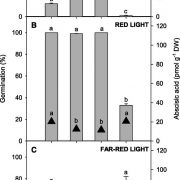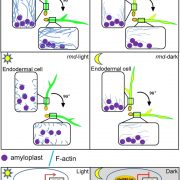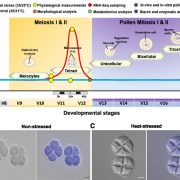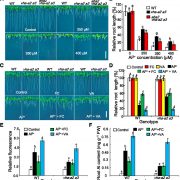
Smoke and Lettuce Seed Germination
Plant Physiology, Plant Physiology: On The InsideWildfire smoke contains certain potent bioactive compounds (butenolides) that play a major role in regulating the germination of many plant species, predominantly grasses and shrub species from fire-prone ecosystems but also many non-fire-dependent plants such as rice (Oryza sativa), wild oats (Avena…

Actin Binding Protein and Negative Gravitropism
Plant Physiology, Plant Physiology: On The InsideGravity is a key determinant in orienting plant stems for proper growth and development. An intact and dynamic actin cytoskeleton is thought to be important for plants to respond to gravity; however, pharmaceutical treatment and mutant analyses have yielded conflicting results. In Arabidopsis (Arabdopsis…

Heat Stress: Two New Insights
Plant Physiology, Plant Physiology: On The InsideHigh temperatures caused by climate change are predicted to decrease cereal productivity in many parts of the world. Yield losses due to rising temperatures have already been reported for major cereal crops including maize (Zea mays), wheat (Triticum sp.), and rice (Oryza sativa). These cereals together…

Vacuolar H+-ATPase Regulates Al Resistance
Plant Physiology, Plant Physiology: On The InsideIn acidic soils, phytotoxic levels of active aluminum (Al) are released from Al-containing minerals when the pH drops to 5 or lower. These active Al forms, primarily Al3+, often threaten root vitality and inhibit primary root elongation, thus limiting the acquisition of nutrient elements and water necessary…

Turnip Mosaic Virus is Released into Extracellular Space
Plant Physiology, Plant Physiology: On The InsideTurnip Mosaic Virus (TuMV) is a +RNA virus that belongs to the order Picornavirales. +RNA viruses reorganize the endomembrane system to generate quasi-organelle structures called “viral factories”. In the case of TuMV, these factories are motile vesicles of ~100 nm in diameter that contain the TuMV…

Regulation of Imprinting in Arabidopsis
Plant Physiology, Plant Physiology: On The InsideThe seeds of flowering plants consist of three genetically distinct components: the diploid embryo with one genome copy from each of the parents, the triploid endosperm with two maternal copies and one paternal copy, and the seed coat having the same genotype as the diploid mother plant. Balanced parental…

Salicylic Acid Influences Root Meristem Patterning at Low Concentrations
Plant Physiology, Plant Physiology: On The InsideHigh exogenous concentrations (>50 µM) of salicylic acid (SA) stimulate systemic acquired resistance (SAR), a vitally important adaptive immunity response that protects against a broad spectrum of pathogens. The transcription of PATHOGENESIS-RELATED GENE 1 (PR1) is rapidly induced in leaves upon…

The Spatial Distribution of Chlorophyll in Leaves
Plant Physiology, Plant Physiology: On The InsideThe biochemistry of photosynthesis and biophysical processes that constrain it are intrinsically linked within the landscape of the inner leaf. Because leaf tissue is heterogeneous in structure as well as photosynthetic capacity, it follows that chlorophyll may also be spatially heterogeneous. Yet, while…

Domestication Affected Root System Architecture in Common Bean
Plant Physiology, Plant Physiology: On The InsideComparative analyses of wild and domesticated accessions have previously identified several aboveground domestication-related traits in common bean (Phaseolus vulgaris). Genetic analyses of these traits suggested the presence of several major quantitative trait loci (QTLs) with large effects. However,…

